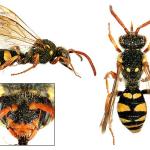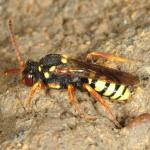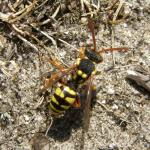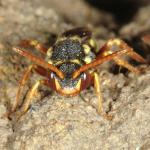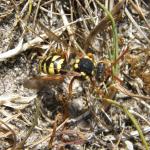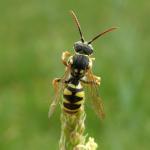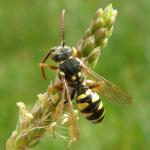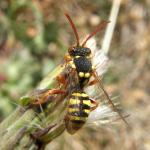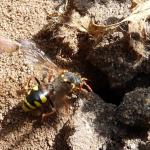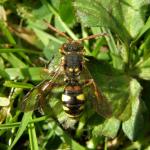Both Nomada fulvicornis and N. marshamella (Kirby) greatly resemble one another in the field, particularly males. However, the females of N. fulvicornis generally have obvious reddish markings on the more basal sternites and similar ones are often (though much reduced) present on some of the tergites. In the males there are no inner orbital yellow or orange bands in N. marshamella; these are present in N. fulvicornis but are frequently reduced to a few small spots. N. fulvicornis has two distinct subspecies in Britain, these expressing themselves in subtle colour differences, tergite and sternite markings and the overall size of both sexes. That associated with Andrena nigrospina is referable to subspecies subcornuta (Kirby), whilst populations attacking the nests of closely related Andrena species (see below) are subspecies fulvicornis Fabricius. These subspecies are described and discussed in some detail by Falk (2005).
Widely distributed, from Kent to Cornwall, north through central England to Yorkshire. There is an old record from Glamorgan (Hallett, 1928) and recent records from Pembrokeshire. There are no records from northern Britain or Ireland, but the species is known from several of the Channel Islands (Saunders, 1902; Richards, 1979).
This bee occurs throughout much of Europe, from Fennoscandia, south to Spain and Corsica, east to Turkey. It is present in North Africa (Morocco) and Japan (Hirashima, 1982).
Listed as Rare (RDB3) by Shirt (1987) and by Falk (1991).
This varies with the various host Andrena with which the cleptoparasite associates. In the main, the bee is often encountered on sandy soils, coastal cliffs and landslips and, more rarely, chalk grassland.
The subspecies that is a cleptoparasite of Andrena bimaculata (Kirby) and A. pilipes Fabricius is bivoltine, flying from late March to early June, and again from late June to the end of August. The subspecies associated with A. nigrospina Thomson and the form parasitising A. tibialis (Kirby) are univoltine, being active from late March to June.
Nomada fulvicornis is a cleptoparasite of Andrena species in the subgenus Plastandrena: A. bimaculata (Kirby) (Perkins, 1919, 1924), pilipes Fabricius [as A. carbonaria] (Perkins, 1919, 1924; Chambers, 1949), nigrospina Thomson (Falk, 2005) and tibialis (Kirby) (Perkins, 1919, 1924; Spooner, 1931; Yarrow, 1941; Guichard & Yarrow, 1948). In mainland Europe, it is additionally reported to attack both A. thoracica (Fabricius) (Kocourek, 1966) and A. agilissima (Scopoli) (Stöckhert, 1933).
Those N. fulvicornis active in the spring fly to thrift, white willow, creeping willow, cabbage, spurge and daisy, whereas those active in the mid-summer period visit bramble, rosebay willowherb, goldenrod, ragwort and creeping thistle.
No data available.
2012


